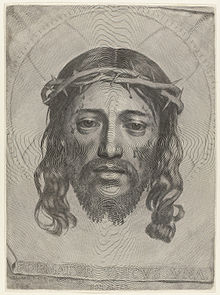Claude Mellan
Claude Mellan | |
|---|---|
 Self-portrait, engraving by Claude Mellan (1635), Metropolitan Museum of Art | |
| Born | 23 May 1598 Abbeville, France |
| Died | 9 September 1688 (aged 90) Paris, France |
Claude Mellan (23 May 1598 – 9 September 1688)[a][1][2] was a French draughtsman, engraver, and painter.[3]
Early life and training
Mellan was born in Abbeville, the son of a customs official.[4]
His first known print (Préaud no. 288[b]), made for a thesis in theology at the Collège des Mathurins, shows that he was in Paris by 1619.[3][c] His first teachers have not been identified, but his early engravings are thought to show the influence of Léonard Gaultier.[3]
Rome
In 1624 Mellan went to Rome, where he studied engraving for a brief time with
Later years in Paris
In 1637, after a period of time in
The effect, which he produced by this method of engraving, is soft and clear. In single figures, and small subjects, he succeeded very happily; but in large subjects, where great depth of shadow was required, he has failed....[5]

Particularly notable is his engraving The Face of Christ (1649; Préaud no. 21), also called the Sudarium of Saint Veronica (see Veil of Veronica), created from a single spiralling line that starts at the tip of Jesus's nose.[3][4]
During this later period in Paris, Mellan mostly engraved his own work. He was much sought after as a portrait artist, drawing from life and engraving the portraits. Among his subjects were members of the
He also created large religious works with geometric layouts and poses. According to Barbara Brejon de Lavergnée, writing in
He died in Paris.
See also
- Maddalena Corvina, fellow painter and subject of Mellan
Notes
- ^ 23 May 1598 is his date of baptism.
- ^ Engraving catalog numbers are from Préaud 1988.
- ^ The Collège des Mathurins was a constituent college of the Sorbonne (see fr:Université de Paris).
References
Bibliography
- Brejon de Lavergnée, Barbara (1996). "Mellan, Claude". In Turner, Jane (ed.). The Dictionary of Art: In Thirty-four Volumes. Vol. 21 (Reprinted with minor corrections ed.). New York: Grove. pp. 85–86. ISBN 9781884446009. Also at Oxford Art Online(subscription required).
- Chilvers, Ian (2009). The Oxford Dictionary of Art and Artists (4th ed.). Oxford: Oxford University Press. ISBN 9780199532940.
- Montaiglon, Anatole de; Mariette, Pierre Jean (1856). Catalogue raisonné de l'oeuvre de Claude Mellan d'Abbeville (in French). Abbeville: P. Briez. Retrieved 2 January 2024.
- Préaud, Maxime (1988). Inventaire du fonds français: Graveurs du dix-septième siècle. Tome 17, Claude Melan. Paris: Bibliothèque Nationale. ISBN 9782717717778.
- Strutt, Joseph (1786). "Claude Mellan". A Biographical Dictionary Containing an Historical Account of All the Engravers, from the Earliest Period of the Art of Engraving to the Present Time. Vol. 2. New Bond Street, London: J. Davis, For Robert Faulder. pp. 142–144. Retrieved 2 January 2024. Vols. 1 and 2 at Google Books.
External links
- Orazio and Artemisia Gentileschi, a fully digitized exhibition catalog from The Metropolitan Museum of Art Libraries, which contains material on Claude Mellan (see index)
